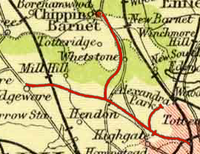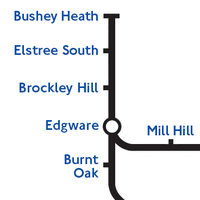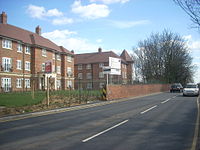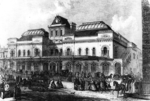- Mill Hill (The Hale) railway station
-
Mill Hill (The Hale) 
Location Place Mill Hill Coordinates 51°36′41″N 0°14′55″W / 51.6114°N 0.2485°WCoordinates: 51°36′41″N 0°14′55″W / 51.6114°N 0.2485°W History Opened by Great Northern Railway Platforms 1 Key dates Opened 1906
Closed 1939Replaced by none Mill Hill (The Hale) railway station was a station in Mill Hill, London NW7 on the now-removed railway between Mill Hill East station and Edgware railway station. It was located near the junction of Bunns Lane and Lyndhurst Avenue.
History
The railway line was built by the Edgware, Highgate and London Railway and was opened on 22 August 1867 by the Great Northern Railway (GNR) (which had taken over the EH&LR) in what was then rural Middlesex. The station, then named The Hale Halt, was not opened until 1906, on the single track from Finchley Central to Edgware.[1] The whole line ran from Finsbury Park to Edgware via Highgate with branches to Alexandra Palace and High Barnet.
After the 1921 Railways Act created the Big Four railway companies, the line was, from 1923, part of the London & North Eastern Railway (LNER). The station was named Mill Hill (The Hale) in 1928.
 Northern Heights plans
Northern Heights plansIn 1935 London Underground devised a "New Works Programme" of improvements, and planned to take over the line from the LNER in its "Northern Heights" plan. The line was to be modernised for use by electric trains on double track, and amalgamated with the Northern Line.
 How Mill Hill tube station would appear on the London Underground Map today if the Northern Line extension from Edgware to Bushey Heath and Mill Hill East had been completed
How Mill Hill tube station would appear on the London Underground Map today if the Northern Line extension from Edgware to Bushey Heath and Mill Hill East had been completed
Works began in the late 1930s and were at an advanced stage when they were interrupted by the Second World War. The section of line between Finchley Central station and Edgware was closed to passenger services on 10 September 1939. On the Edgware branch of the line, only the works on the section from Finchley Central to Mill Hill East were completed, to allow access to and from the nearby army barracks. That section reopened with Underground services in 1941 as a one-station spur.
After the war a shortage of funds led to the cancellation of the Northern Heights work in the early 1950s. Mill Hill (The Hale) was the only station between Edgware and Mill Hill East and, as Edgware was already served by the Underground from its own station in the town and Mill Hill was served by the nearby London Midland and Scottish Railway (LMS) Mill Hill Broadway station, there was little need for the completion of the track modernisation works and the reopening of the line for passenger services. The line continued to be used for goods until 29 February 1964 when it was completely closed.[2]
Until the early 1970s it was possible to buy an Underground ticket to "Mill Hill The Hale" even though no such station had existed for years. This enabled passengers to keep their tickets upon alighting at Mill Hill East and to travel onward by 240A bus anywhere between Mill Hill and Edgware.
Today the track has been removed and the platforms and station buildings have been demolished. The site of Mill Hill (The Hale) station was covered by material excavated for the construction of slip roads to the nearby section of the M1 motorway.
In 2007 work began to build flats on the site of the former station, but the bridge over the former tracks remains.
Former Services Preceding station Disused railways Following station Edgware EH&LR
Mill Hill LineMill Hill East Abandoned Works Abandoned Northern Heights Extension Preceding station  London Underground
London UndergroundFollowing station towards Bushey HeathNorthern line towards Morden or KenningtonReferences
- ^ Connor, J. E.(2000). Abandoned Stations on London's Underground, Connor and Butler Ltd. ISBN 0 947699 30 9.
- ^ Hardy, Brian, ed (March 2011). "How it used to be - freight on The Underground 50 years ago". Underground News (London Underground Railway Society) (591): 175–183. ISSN 0306-8617.
External links
London Underground closed stations and abandoned plans Closed stations Central: Blake Hall · British Museum · Wood Lane — District: Hounslow Town · Mark Lane · Osterley & Spring Grove · Park Royal & Twyford Abbey · South Acton · St Mary's · Tower of London — East London: Shoreditch — Jubilee: Charing Cross — Metropolitan: Hammersmith (Grove Road) · Lord's · Marlborough Road · Swiss Cottage · Uxbridge Road · Wood Lane — Northern: City Road · South Kentish Town · King William Street — Piccadilly: Aldwych · Brompton Road · Down Street · York Road
Abandoned plans Bakerloo: Extension to Camberwell — Central: Denham · Harefield Road · Extension to Richmond — Jubilee: Ludgate Circus — Northern: Alexandra Palace · Brockley Hill · Bushey Heath · Cranley Gardens · Crouch End · Elstree South · Highgate (High level) · Mill Hill · Muswell Hill · North End · Stroud Green — Great Northern & City: Lothbury — Great Northern & Strand: Wood Green · Hornsey · Harringay — City & Brixton Railway — Edgware Road Tube schemes
Northern line Stations High Barnet branchEdgware branchBelsize Park · Brent Cross · Burnt Oak · Camden Town · Chalk Farm · Colindale · Edgware · Golders Green · Hampstead · Hendon CentralCharing Cross branchBank branchAngel · Bank · Borough · Camden Town · Elephant & Castle
· Borough · Camden Town · Elephant & Castle  (100m) · Euston
(100m) · Euston 
 · King's Cross St. Pancras
· King's Cross St. Pancras  · London Bridge
· London Bridge  · Moorgate
· Moorgate  · Old Street
· Old Street  Morden lineBalham · Clapham Common · Clapham North · Clapham South · Colliers Wood · Kennington · Morden · Oval · South Wimbledon · Stockwell · Tooting Bec · Tooting BroadwayFuture
Morden lineBalham · Clapham Common · Clapham North · Clapham South · Colliers Wood · Kennington · Morden · Oval · South Wimbledon · Stockwell · Tooting Bec · Tooting BroadwayFuture

Click to enlargeRolling stock Present stockHistory Former companiesFormer linesFormer stationsFormer rolling stock1906 Stock · 1938 Stock · 1949 Stock · 1956 Stock · 1959 Stock · 1962 Stock · 1972 Stock · Standard StockAbandoned plansNorthern Heights plan · Alexandra Palace · Brockley Hill · Bushey Heath · Cranley Gardens · Crouch End · Elstree South · Mill Hill · Muswell Hill · North End · Stroud GreenLondon Underground · Transport for London
Categories:- Disused London Underground stations
- Railway stations opened in 1906
- Railway stations closed in 1939
- Proposed London Underground stations
- Never constructed Northern Heights extension stations
- Disused railway stations in Barnet
Wikimedia Foundation. 2010.


